
Presentations In 2011
NOTE: Many of the following presentation summaries will include links to the Power Point slides used to illustrate the presentation.
Click HERE for instructions on how to control the slide show.
Click Top of Page above to return to 2011 index
Vol 88 No 26 - July 11, 2011
Discovering the Science of the Environment and Results of Foundation Boat Trip
Presented By: Brooke Furge & Kara Salazar, IUPUI Center for Earth & Environmental Science (CEES)
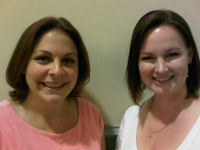
Brooke Furge
and Kara Salazar
Today's guest speakers were from The Center for Earth and Environmental Science at IUPUI. Brooke Furge, DSE Education Specialist and Kara Salazar, Education Outreach Coordinator were introduced to us by member, Doug Wagner. Brooke came to IUPUI from the Indiana Dunes Environmental Learning Center where she taught outdoor environment education as a naturalist. Kara implements outreach programs and science-based curriculum for university students, K-12 students and teachers, community members and environmental professionals.
Kara spoke to us first to give us an overview of the many initiatives of CEES. As an Urban Environmental Center, they strive to provide environmental research, Science Education and Public Service. Their research initiatives include: Wetland Ecosystem Restoration, The Fate and Transport of Environmental Contaminates, Water Resources Evaluation and Environmental Data Management and Visualization. It is from their Environmental Science Education initiative that the program, Discovering the Science of the Environment arose.
Brooke spoke to us at length regarding the many educational programs that have been developed and delivered to Marion County and Central Indiana students as a result of this special, grant-funded program. Utilizing a mobile resource trailer equipped with interactive technology tools, web interface, and GPS mapping capabilities, the DSE program travels to schools to provide FREE educational programming at school ground natural areas. They are able to offer schools the ability to have both potential funding and training to establish their own outdoor, environmental labs for their students to learn about water quality studies, wetland exploration, and even urban studies that include measuring air quality. Last year, they taught over 10,000 students in over 400 schools the importance of each person's role in improving environmental quality and sparked interest in career pathways in science, engineering and technology.
One of the CEES special programs is the annual boat trip to Lake Michigan. Our member, Mr. Bill Elliott, attended the Grand Valley State University water resources trip. It was attended by nine area students, two teachers and a few parents. The trip was preceded by a meeting the week before in which students and parents were introduced to one or two of the chaperones, and Brooke. She gave them an overview of the trip and the importance of fresh water resources. She had a demonstration of the importance of fresh water by having 1000 ml beakers of water on each table which represented the world water supply, one drop of which represented potable fresh water. She used an inflated globe which the students passed around, and as each caught the globe, they gave their name and school. Then they told everyone if their right thumb was on land or water when they caught the globe, demonstrating just how much water is located on the earth, of which only a very small percentage is potable. Finally she demonstrated the effects of human actions in dirtying the clean water. They eventually ate at the Annis Water Resources Institute on Lake Muskegon, toured the Lake Michigan AWRI Center and Muskegon Field Station, toured the sand dunes in Hoffmaster State Park and swam in Lake Michigan. They visited Grand Haven, walked the boardwalk and attended the musical fountain show. They ended their trip with a tour of the Air Museum at Grissom Air Force Base.
A bit of history - AWRI refers to the Annis Water Resources Institute. Bob Annis was a Scientech Club member who donated considerable monies to build up the Institute. D.J. Angus, also a club member, and founder of the D. J. Angus Foundation, gave his yacht to the institute for use in scientific research on Lake Michigan.
Unfortunately, the slides from this talk are not available at the request of the speakers
Notes by Veronica Foote
Vol 88 No 27 - July 18, 2011
Tour of French Lick and West Baden Hotels
Tour Guide: Ms. Sandi Woodward, Indiana Landmarks
Nestled in the Hoosier National Forest, this valley has long been an attraction because of the many mineral water springs found here. The free-flowing mineral water left a residue of salt on the rocks surrounding the springs, which attracted animals such as deer and buffalo to lick the salt off the rocks. In 1833 Dr. William Bowles, a physician from Paoli, bought 15,000 acres of land; he began to develop it and by 1845 had built the first "French Lick Springs" Hotel. Tom Taggart, the mayor of Indianapolis, along with a small group of seven investors, formed the French Lick Hotel Company and bought the property in 1901.
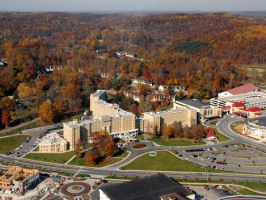
French Lick Springs Hotel
It was under Tom Taggart's imaginative rule that the French Lick Springs Hotel rocketed to international prominence. He had the Monon Railroad lay a special spur and run daily trains between Chicago and the front entrance of the hotel.
The intriguing history of Southern Indiana's West Baden Springs Hotel extends to 1778 when George Rogers Clark is said to have discovered the area's mineral springs and salt licks. The supposed curative powers of such springs, combined with the idyllic landscape of southern Indiana, have been a draw throughout the years to people searching for relief from the stresses of the workaday world.

West Baden Springs Hotel
In 1888 Lee W. Sinclair acquired controlling interest in the West Baden hotel and within a few years was its sole owner. He transformed it into a sophisticated resort, adding an opera house, a casino, a two-deck pony and bicycle track and a full-size baseball field. All the guests escaped harm when a fire destroyed the entire hotel building in less than two hours in June 1901.
After years of decay, a corporate benefactor, Cook Group Incorporated of Bloomington, Indiana immediately began stabilization and partial restoration to make the property more attractive for redevelopment.
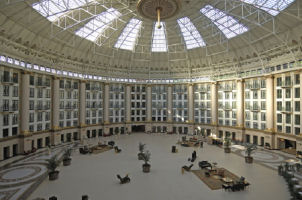
West Baden Lobby
Highlights of the tour of the French Lick Resort included the Main Lobby which has had the lighting and columns completely restored as well as the Gold Leaf Work in the Lobby, and the Silver Leaf work in the Silver Room.
West Baden was a much more impressive Hotel than the French Lick Hotel. The building was circular with a large central area covered by a circular dome. Of the two hotels, West Baden was by far a personal favorite.
Click HERE for further information on the re-building of both of these hotels included in the talk by Claude McNeal last April.
Click HERE to see a series of great photos taken on this trip by John Morrical.
Notes by Bill Elliott
Vol 88 No 28 - July 25, 2011
Tour of Classic Italy
Presented By: Dr. Charles Shoup, Past-President, Scientech
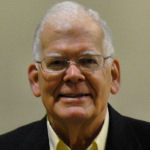
Dr. Charles Shoup
Dr. Charles Shoup is a past president of the Scientech Club. He received his bachelor's degree from Princeton and his PhD in chemistry from the University of Tennessee. He was the Director of Corporate Research at Cabot Corporation.
He presented a very interesting illustrated talk on the tour he and his wife made of Classic Italy. The photographs in the presentation were amazing.
Click HERE for a slideshow of these pictures.
The tour began at Sorrento, which is south of Naples. From Sorrento, they drove along the Amalfi Coast, where the road is on the side of a cliff overlooking the sea, to the town of Amalfi. A garden on the edge of a cliff, overlooking the sea, was remarkable.
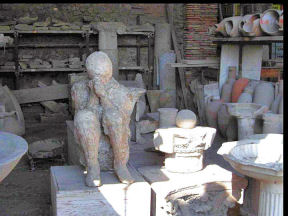
Pompeii Cast
From Amalfi, they went to Pompeii, which was covered with 15 to 20 feet of volcanic ash and rock in AD79, when the volcano Mt. Vesuvius erupted. The ancient town was excavated, resulting in the discovery of elaborate public baths, together with restaurants, shops and houses. Bodies of the deceased residents at the time of the eruption were also found. There is also a modern city of Pompeii.
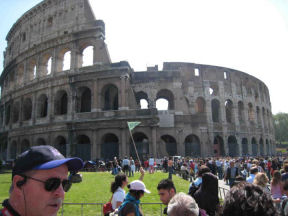
Rome Coliseum
At Rome the Coliseum was originally covered in white marble. Most of the white marble is now gone as it was used for other construction. Later, the tour passed the white mountains from which the marble came.
In Italy, tourists were everywhere. Italy is one of the best places to watch people. The tour went to the fountain featured in the movie, Three Coins in the Fountain, an excerpt of which was presented.
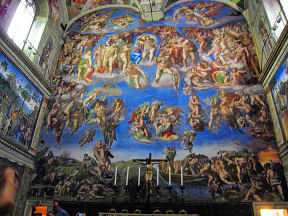
Michelango Painting
Rome is full of churches, including the Basilica of St. Peter in Chains, with what was stated to be the original chains. At the Vatican, the Last Judgment and the other paintings by Michelangelo have been restored. Forty years ago, they were covered by the residue left by generations of smokers. Now they are clean and bright.
At Assisi, they toured the Basilica of St. Francis, which is actually an upper basilica and a lower basilica, with 49 steps between them. They also found that, like Carmel, Italy has roundabouts.
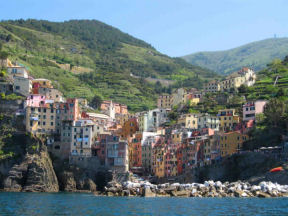
Cinque Terre
They took a boat tour to the Cinque Terre, five towns that used to be reached only by boat. They took the high speed Eurostar train from Florence to Venice at 130 mph. In Italy there are local, regional and high speed trains.
A video of their gondola tour of Venice was shown. In addition to the gondolas, there are less expensive and more practical ferry boats. In Venice, the Bridge of Sighs goes from the Doge's Palace, where criminals were sentenced, to the prison.
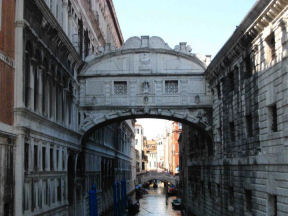
Bridge of Sighs
There was little evidence of WWII damage on the tour. In addition to finding that Italy is a great place to see people, one place to get breakfast there is in bars, which typically have breakfast rolls and coffee. It is impossible to here list all the amazing places presented in the fine presentation.
Notes by Malcolm Mallette
Vol 88 No 29 - August 1, 2011
The Institute for Shipboard Education
Presented By: Alison Brown, Julie Kiefer, Sue Kiefer
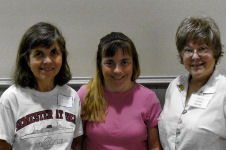
Sue Kiefer, Julie Kiefer
and Alison Brown
Alison, a fellow club member, is a graduate of Sarah Lawrence College. Sue and Julie are graduates of Ball State University with several degrees.
Studying abroad has been known since the time of Herodotus. Pilgrimages to Rome were common in the middle Ages and before. In the 19th century the Grand Tour of Europe and beyond was part of a well-rounded education. Many American students of the arts including music and painting traveled overseas for additional training with the Masters. In the late 1800s J. O. Woodruff of Indianapolis and later James E. Lough of New York believed that changes were needed in the traditional teaching methods of American universities. Travel and first-hand experience abroad were considered to be very important in every student's education.
The first shipboard multi-country study abroad was in 1926. This was discontinued after 1936 but resumed again in 1963 aboard the Holland America ship SS Ryndam. At that time the idea was resurrected under the name of the University of the Seven Seas with the visionary leadership of a California businessman, Bill Hughes, and a wealthy Chinese shipping magnate, C.Y.Tung. He said "ships carry ideas as well as cargo." Since 1963 Semester at Sea has sailed on more than 100 voyages educating more than 50,000 students from 1500 institutions visiting 60 countries. Affiliations in the past have been with Chapman College, the University of Pittsburgh and more recently the University of Virginia including its famous code of honor.
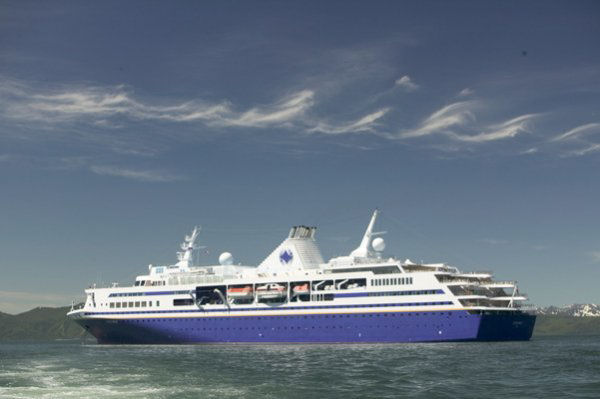
MV Explorer
The Kiefers as well as Alison Brown have all experienced one or more voyages on the ships. The newest, MV Explorer, has been used since 2004. It is a completely modern vessel with all of the amenities including nine classrooms, an exercise room and a spa. A typical voyage has 720 undergraduate students, 20 or more older lifelong learners who are adult travelers participating in the classes as well as the land experiences, 35 or more PhD faculty members and at least that many qualified staff including graduate students. There are fall and spring voyages around the world lasting 100 to 110 days. These include 10 to 12 international destinations. The enrolled students may earn 12 to 15 transferable credits. The cost for a semester at sea is about the same as the cost of a semester at a private college or university. There are some voyages lasting 65 to 70 days where one could earn up to 12 transferable credits. The courses offered are many including anthropology, art, architecture, business, drama, geology, history, music and political science.
The Semester at Sea program is operated as an educational nonprofit organization by the Institute for Shipboard Education. The MV Explorer is one of the safest and fastest ships afloat. There is a physician and medical staff aboard at all times to handle emergencies. The organization currently has a $5 million endowment looking to reach a goal of $15 million. This money is used for scholarships for needy students. More than 60% of the students receive grants, external scholarships, loans or work- study opportunities.
Anyone interested in participating as a student or an older lifelong learner may contact Semester at Sea at www.semesteratsea.org/discover.
Notes by Gerald Kurlander
Vol 88 No 30 - August 8, 2011
Sails, Sailing & Aero/Hydrodynamics
Presented By: Bonnie Carter
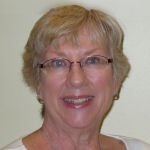
Bonnie Carter
Our presenter today was Bonnie Carter, retired from a career in nuclear medicine. Bonnie is a Scientech member and an editor of our newsletter. Today's talk was a sequel to her June 6 presentation in which the K of C projector system failed.
Bonnie's talk covered a wide range of history and techniques of sailing. This write-up will focus on the physics of sailing from today's talk. It will complement Malcolm Malette's write up posted on this website for Bonnie's June 6 presentation.
"Sailing is magical, but it is not magic." The principles of modern sailing are unchanged even though the technology has greatly advanced and continues to do so. An 18th century sailor could instinctively sail a modern sailboat.
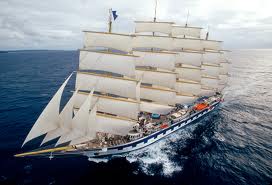
Royal Clipper
Sailboats can move both with and against the wind, just not directly into the wind. Bernoulli's principle applies to a sail like it does to an airplane wing. Air moving across a curved surface moves faster and, thus, at lower pressure. This creates a sucking or "lifting" or pulling force to move the sailboat. The wind creates lift (the driving or pulling force), a sideways force, and a heeling (tipping) force. These forces are balanced by the trimming of the sails, the heading (direction) of the boat and the counterbalancing effect of the keel. The sum of the vector forces causes the boat to move in the direction of the "apparent wind." This is an angle formed between the true wind direction and the heading of the boat. As a result, to move from point A to B, the boat is actually headed off course so the "apparent wind" direction is pointed to B.
The wind generates aerodynamic lift (pulling) and aerodynamic drag (sideways) and the water against the keel generates hydrodynamic drag and hydrodynamic lift. These forces may not apply at the same point on the craft and generate a bow-to-stern longitudinal torque. This must also be balanced by the skill of the captain.
Factors affecting the speed of the boat include resistive forces, hull speed, and sail design.
Resistive forces include:
- Frictional Resistance between water and the hull (van der Waals "Shear"). Smaller surface area is better as in catamarans
- Turbulence at higher speeds & rough surface
- Induced drag from vortices caused by the sails and keel
- Form resistance from hull geometry
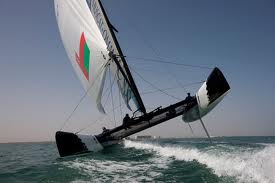
America's Cup Racer
Hull speed occurs when a boat climbs its own bow wave. This drag effect is minimized when the boat rides on top of a bow and stern wave.
Sail design is constantly evolving. A triangle sail of equal area to a rectangular generates 4 times the aerodynamic lift, partially due to having only one edge not supported. The jib (sail on the bowsprit) interacts with the mainsail to make them both more efficient. Triangular sails are being designed with a flat top to reduce their vortices. Another new concept is to design the bottom side of rectangular sails with an elliptical shape to reduce the vortex.
As an aside, large spinnaker sails are being tested on ocean going freighters. Tests show a 1/3 fuel savings and about 15% faster speed.
Bonnie's adventure was on the Royal Clipper, whose beam is nearly equal to the length of Columbus's sailboats - a truly magnificent luxury sailing ship. As she commented: it was a true "bucket list" adventure.
Click HERE to see the slides used in this presentation
Notes by John Peer
Vol 88 No 31 - August 15, 2011
The History of Alcoholics Anonymous in Indiana
Presented By: Bob S & Bruce C ( AA members don't use their full names in public.)
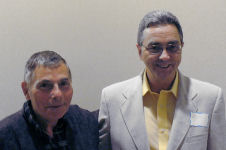
Bob S and Bruce C
The founders of AA were Bill W and Dr. Bob S, who met in Akron, OH in May, 1935. Dr. Bob took his last drink on June 10, 1935, and AA marks its beginnings from that date.
James D H brought AA to Indiana in 1938. He was the 10th man to join AA. He moved to Evansville and started looking for an alcoholic to recruit. He heard of Dr. Joe W, who was a surgeon, and asked him for a brief talk, without result. In the spring of 1940, James heard that Joe was in jail and wanted to see him. James then sent Joe to visit Dr. Bob S, who recruited Joe to AA. Joe then referred 2 or 3 patients to James, and soon regular AA meetings were being held in James' home.
James was a persuasive and forceful speaker for AA, and by February, 1941, the Evansville group had 37 regular members.
Doherty S. of Indianapolis was largely responsible for the growth of AA in Indiana. He had struggled with alcohol since 1936. He wrote to a New York alcoholic foundation, which referred him to a Cleveland group. That group sent Irwin M. to help him in 1940, and Irwin put him in touch with James D. H. At that time there were only 5 AA members in Indianapolis. Doherty was a powerful recruiter and soon there were 10 sober people in the city.
In March, 1941, the group in Richmond IN was running newspaper articles inviting drinkers to contact them for help.
By July, 1941, Indianapolis started Sunday morning breakfast meetings for AA members and
prospects. Meetings were being held in at least 4 hotels every week.
Another Indiana innovation was the establishment of homes for the treatment of alcoholics. The first one was Indiana Home, which was largely started by Doherty S. in 1945 at 1341 N. Alabama. It later was on N. Delaware, and was the parent of the present Fairbanks Addiction Treatment Center.
Other Indiana firsts include the first intergroup office, in 1948, and the introduction of tokens or medallions to identify members to each other. Indiana was probably the second group to start AA meetings in prison. In late 1942 or early 1943 meetings were started in the Putnamville facility, soon after San Quentin did the same.
AA has grown to two million members worldwide, and one million in the United States. Despite its great size, it is still growing. At the present time, about 1300 AA groups are meeting in Indiana.
Notes by Joe Jones
Vol 88 No 32 - August 22, 2011
Discovery at Purdue
Presented By: Dave Kotterman, BSIE, MBA, Managing Director for Launching Centers & Institutes, Purdue University
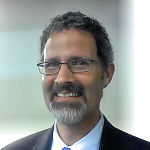
Dave Kotterman
A university, collaborative, partnering, research environment is the trend of the future. No longer are universities able to function in independent silos of research. Funding agencies are offering large competitive rewards to those universities and industries which complement each other's strengths so that the greatest impact can be realized. Purdue receives most of its research funding from the NSF, Dept. of Health, industry and foundations.
Where is Purdue now? Hockmeyer Hall will increase capability by 16 laboratories in the areas of protein production, virus culture and large molecule crystallization. The Hall of Discovery and Learning Research opened in 2009 and is the main headquarters for multiple large interdisciplinary centers.
Where is Purdue going? The trend is toward increased research in the fight against cancer and in advancing biosensoring in the life science areas.
The Bindley Bioscience Center is planning an addition to double its size by providing shared laboratory space for the Multidisciplinary Cancer and Disease Research Facility.
For many years Purdue had no avenue to communicate the results of research to inform public and government policy makers so that data-based decisions could be made. As a result the Global Policy Research Institute (GPRI) was established.
In an effort to support education in Indiana, the NIH awarded IU, Notre Dame and Purdue the Indiana Clinical and Translational Sciences Institute with headquarters at Purdue.
The Grand Challenges in Energy, Water, Environment and Climate, their dependence and effects on each other, combined with their global implications, led to the creation of the Global Sustainability Initiative (GSI) which has created five focused research areas. Two of those areas are the Energy Center and the Food Security Center.
1) The Energy Center conducts high risk, high reward research to advance the development of chemical catalysis in the production of biofuels.
2) The goal of the Center for Food Security is to provide leadership to strengthening global partners in areas of global nutrition.
Facts:
Global Population in 2010 about 6.0 billion - - - Estimate in 2050 about 9 billion
This will require a 40-50%, possibly a 70% food production increase. We need to double our present food production within four decades.
Climate - The evidence is clear: how we live our lives affects the climate.
Water -the most critical commodity. 70% of available fresh water is used by agriculture; 30% is used by residential and industrial applications.
Energy - There is currently a 2-3% annual increase. In four decades we will need to double our energy output.
Policy and Governance -This has become a very important area that will give science and technology a chance to create scientific solutions to solve these problems. It is not about every country unto itself anymore, because trouble starting elsewhere will eventually make its way to the Unites States.
The largest grant ever received by Purdue is in Earthquake Simulation. The Network for Earthquake Engineering Simulation (NEES) connects 14 different national sites using state-of-the-art cyber infrastructure to study the effects of earthquakes and develop new methods to mitigate risk and save lives.
Reinforcing the research trends in collaboration, the Indiana Advanced Vehicle Training and Education Consortium focuses on supporting the fast growing electric-vehicle industry.
Purdue's view of Over-the Horizon Research
Leverage the success of the Health and Life Sciences. Plans are in motion to build a Life and Health Science Quadrangle that will create a collaborative environment between research, academic and student life. The main facility will be used for Speech Language Hearing Sciences and Medical Education with clinical facilities. The Drug Facility will have ground-breaking research in biochemistry related to drug discovery, at a total investment of $79 million.
Notes by Jim Bettner
Vol 88 No 33 - August 29, 2011
What's Wrong with this Picture: The Technical Analysis of a Known Forgery
Presented By: Gregory Smith, PhD, Otto N. Frenzel III Senior Conservation Scientist at the IMA
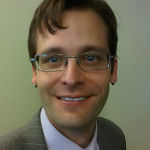
Gregory Smith
Dr. Smith is a graduate of Center College of Kentucky. He has had education in chemistry, anthropology, archaeology, art history and art as well as a PhD degree in analytical chemistry from Duke University.
Conservation science is concerned with the material and chemical aspects of artwork (paintings, leather, ceramics etc.). Specific identification of artists' materials and their degradation products through chemical analysis is a large part of the conservation scientist's job. The information learned is vital in selecting appropriate treatments for artwork undergoing preservation. In addition, contributions can be made in establishing authorship, age, authenticity and state of preservation.
In 2009, the Indianapolis Museum of Art was awarded a $2.6 million grant from the Lilly Endowment to upgrade their conservation studios and to bring a state-of-the-art science lab to the Indianapolis Museum of Art. Scientific instrumentation already installed or to be installed includes instruments for spectroscopy, microscopy, chromatography, thermal analysis and for the determination of accelerated aging.
Museum science includes applied as well as basic research. The majority of work uses analysis to determine "what is this stuff." The conservator needs to know what materials to use to plan a safe and effective remedy. Curators and art historians want technical confirmation of provenance, history, attribution and condition. Raman spectroscopy can be used to authenticate artwork by identifying pigments. Other techniques using the instrumention mentioned above are useful in accomplishing these goals. The conservation scientist can only in-authenticate, i.e. determine that an object is not what it is said to be, but not authenticate an art object.
Using these scientific instruments and creative techniques Dr. Smith proceeded to tell a most interesting story of the art forger Robert L. Trotter and his apprehension by the FBI. Trotter very cleverly forged works of the primitive artists Ammi Phillips and John Haberle. He was an amateur self-taught artist. In assisting the FBI in the capture and conviction of this felon, various techniques were used including visual examination, nonsampling, noninvasive diagnostic techniques such as radiography, x-ray fluorescence, ultraviolet induced fluorescence and infrared reflectography. To apply these and other techniques for invasive sampling including cross-sectioning and Fourier transform infrared microscopy, a minimal amount of material is required the size equal to one quarter of sentence period.
To establish in-authenticity, studies were done of the canvas and lining material, constituents of the paints and pigments, frames and more. To escape detection it would seem that a successful forger would need to be a genius. Presumably there are a few of these around to provide excitement for the conservation scientist.
Notes by Jerry Kurlander
Vol 88 No 34 - September 12, 2011
Fat Dogs & Coughing Horses - Animal Contributions to a Healthy Citizenry
Presented By: Dr. Sandra Amass, Professor, Food Animal Production Medicine, Veterinary Clinical Sciences, Purdue University
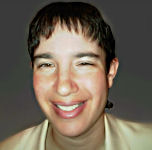
Dr. Sandra Amass
Engagement is a concept which is embraced as equal to teaching and research. Engagement activities in the Purdue Veterinary School (PVM) include promoting economic development, preschool to 12th grade education, service and experiential learning, and quality of life for constituents, and lifelong learning. In short, their goal is to increase both the knowledge and importance of veterinary medicine among the public, particularly among young people, as well as to provide activities which encourage young people to become veterinarians and related scientists.
PVM increased the size of its freshman class this year from 70 to 84 because of the shortage of veterinarians, particularly in rural areas.
Veterinary students are now 75% female and the population of practicing veterinarians is just over 50% female.
Outreach programs in schools are important methods of engagement. In particular, PVM has major programs for third, sixth and ninth grades.
Third graders focus on nutrition and fitness, comparing their needs with pets' needs.
PVM provides books about pet care and about veterinary careers and opportunities. The veterinarians who are portrayed in the books then visit the classrooms to bring the teaching to life. Pets (including the Fat Dog in the title) are brought in to walk with the children.
Partially incubated eggs and an incubator are provided so the children can see them hatch and start to eat and walk. Parents are invited in and a chick may go home to grow and mature.
Older children design an exercise strategy for their pets, especially dogs. The
Coughing Horse is introduced to them. Horses get asthma from the same causes that afflict us. Children visit PVM's treadmill lab where a trained horse walks and runs while its respiratory functions are monitored.
Programs are offered for high schools which teach more advanced curricula including interpretation of x-ray views, and video and microscope interpretation of cells and pathogens.
PVM offers an in-house Boot Camp for 7th and 8th graders, which teaches suitable material for more interested children.
The PVM Bound program is for interested high school students. It is designed to provide the students with a useful background with which to enter PVM.
Notes by Joe Jones
Vol 88 No 35 - September 19, 2011
3D Medical Imaging for Autostereoscopic Display in Improving Clinical Results
Presented By: Dr. Lauren Christopher, Electrical & Computer Engineering Dept., IUPUI
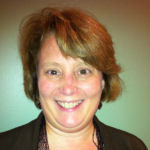
Dr. Lauren
Christopher
Dr. Lauren Christopher received her bachelors and masters degrees in electrical engineering from MIT and her PhD from Purdue. She was elected to the Consumer Electronics Hall of Fame for managing development of the first DirecTV receiver. She is an Assistant Professor of Electrical and Computer Engineering at IUPUI.
The goal of 3D medical imaging is to present preoperative data and live 3D video during medical procedures. 3D perception results from each eye receiving a different image and your brain using multiple cues to perceive depth. The cues the brain uses include a different image for each eye, the vanishing point, lighting and shading and the changing view as the head and eyes change position.
The old stereoscope used two images captured by a purely horizontal translating camera. Corresponding pixels were offset from one image to the other by the same distance on the X axis. An algorithm improvement is to match windows instead of pixels.
Presenting the 3D image used to require the use of anaglyph (red-blue glasses), holography, polarized light (polarized glasses) or shuttered light (active shutter glasses). Now autostereoscopic displays can be used for 3D with no glasses. This avoids the problems of the other display modes. For example, the anaglyph method, using glasses with different colored lenses, often obscured red blood.
The 3D autostereoscopic display has a screen with built in lenses that direct nine different images to the proper eye. The system requires depth information, such as a depth map.
In addition to the depth information and the proper display, using 3D pre-operative data and real time surgery data requires training clinicians in 3D. 3D can also be used for teaching new procedures. For 3D image-guided surgery, a capture device is used to convert the light to electrons and then data. Image processing is followed by a display device to convert the data to light.
There is a Philips ultrasound probe for 3D heart imaging. 3D image capture can be by photographic imagers with micro-lens arrays, capacitive micro-machined ultrasonic transducers, CT and MRI or imagers using 2D plus depth from the amount of defocus. In microscopic surgery, depth can be determined by disparity between the left and right images.
Segmentation and registration are key in isolating tissue types in medical images, calculating a depth map for the image and overlaying real-time data with preoperative data. That requires computational power. Therefore, Dr. Christopher is working on computation of 3D segmentation data. VLSI chip based computation is useful as there is a need for fast computation of large amounts of data.
3D ultrasound segmentation has been used to determine the density of breast tissue. PET segmentation has been used to observe brain reaction to drugs. 3D imaging has also been used for the study of cell function.
After the very informative talk, there was a demonstration of a 3D autostereoscopic display screen which required no glasses.
Notes by Malcolm Mallette
Vol 88 No 36 - September 26, 2011
Outside Art at the IMA
Presented By: Mark Zelonis, IMA Deputy Director of Environmental & Historic Preservation
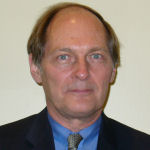
Mark Zelonis
Our presenter today was Mark Zelonis, Director of Environmental and Historic Preservation at the IMA. Mark is a New Hampshire native with a BS in Plant Science from the University of New Hampshire and a MS in Public Horticulture Admin from the University of Delaware. He has been with the IMA since 1997 and been responsible for the restoration and development of all the grounds and buildings outside the IMA building itself. In addition, he is responsible for the recently donated Irwin Miller Home and Gardens in Columbus.
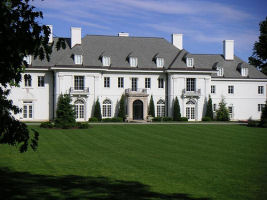
Oldfields
The Oldfields country home (sold to J K Lilly in 1932) was built in 1913. The extensive gardens were designed by Gallagher in the 1920's. The estate was on the interurban railway which was used by the staff to reach the estate. In 1967 the land was donated with the intent to build the IMA. By 1990 the grounds were overgrown. Mark arrived in 1997 and commenced on restoration of the grounds. Having the original plans for the buildings and grounds, Mark and his staff of 25 commenced restoration of the main gardens and also the Ravine Garden between the Lilly House and the Water Co canal to the north. Funds were donated by Dr. and Mrs. George Rapp.
The Lilly House had been used to display the museum's decorative art collection and to store art objects not on display. High humidity was maintained so that the art objects did not crack. Unfortunately this accelerated corrosion of fixtures in the house. From 1998 - 2002 the Lilly House was restored including all the fixtures (e.g. metal window frames). At one point the Library had been painted turquoise. With painstaking effort this paint was removed and the room was fully restored. The work was recognized with the designation of the Lilly House as a National Historic Landmark.
The Four Seasons Garden was restored with a gift from Dick and Helen Dick1nson. It was quite successful as the IMA immediately received many requests for wedding receptions. A "vegetable garden" was also added as an educational tool and was well received.
Mark and his staff researched the concept of a "rain garden" and then constructed one to capture the runoff from the greenhouse parking lot. It was quite successful and, in conjunction with an IUPUI project, the water quality was measured (input vs. output) with excellent results. Others, including the Veolia Water Company, took note and plan to apply their ideas.
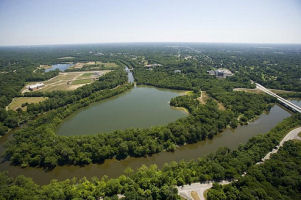
Fairbanks Art and Nature Park
The Virginia B. Fairbanks Art and Nature Park includes the 100 acre park with a 35 acre lake bounded by the oxbow of the White River to the west of the canal. This land was donated by Huber Hunt Nichols in 1971 and had been used as a gravel quarry which quickly filled to form the lake. The land was completely overgrown, but has been developed as a nature and art park by Mark's team. It now boosts 69 species of birds, wetlands, nature trails, and even a LEED (pending) certified Visiroe's Pavilion.

Irwin Miller House
The latest addition to the IMA is the donation of the (Irwin) Miller House and Gardens in Columbus. This 13-acre site was landscaped by Dan Kiley who specializes in geometrical landscape designs to enhance the architectural house design of Eero Saarinen.
The IMA in its entirety is a widely acclaimed asset with 55K art objects and, except for special exhibits, admission is free.
Click HERE to see the slides used in this presentation
Notes by John Peer